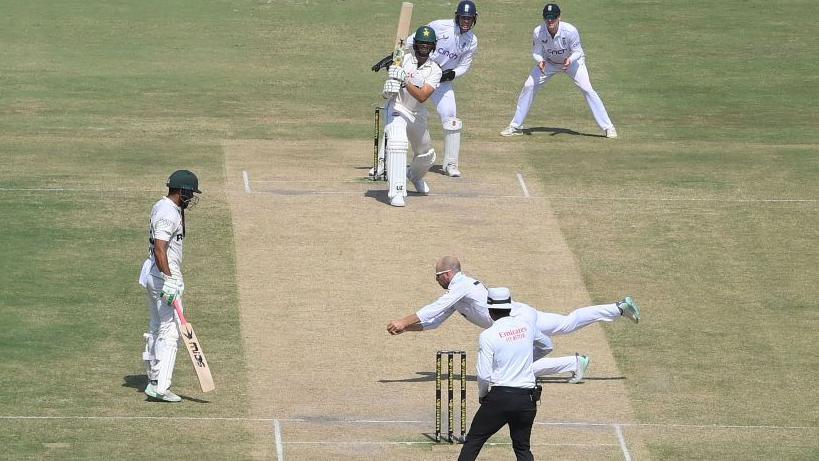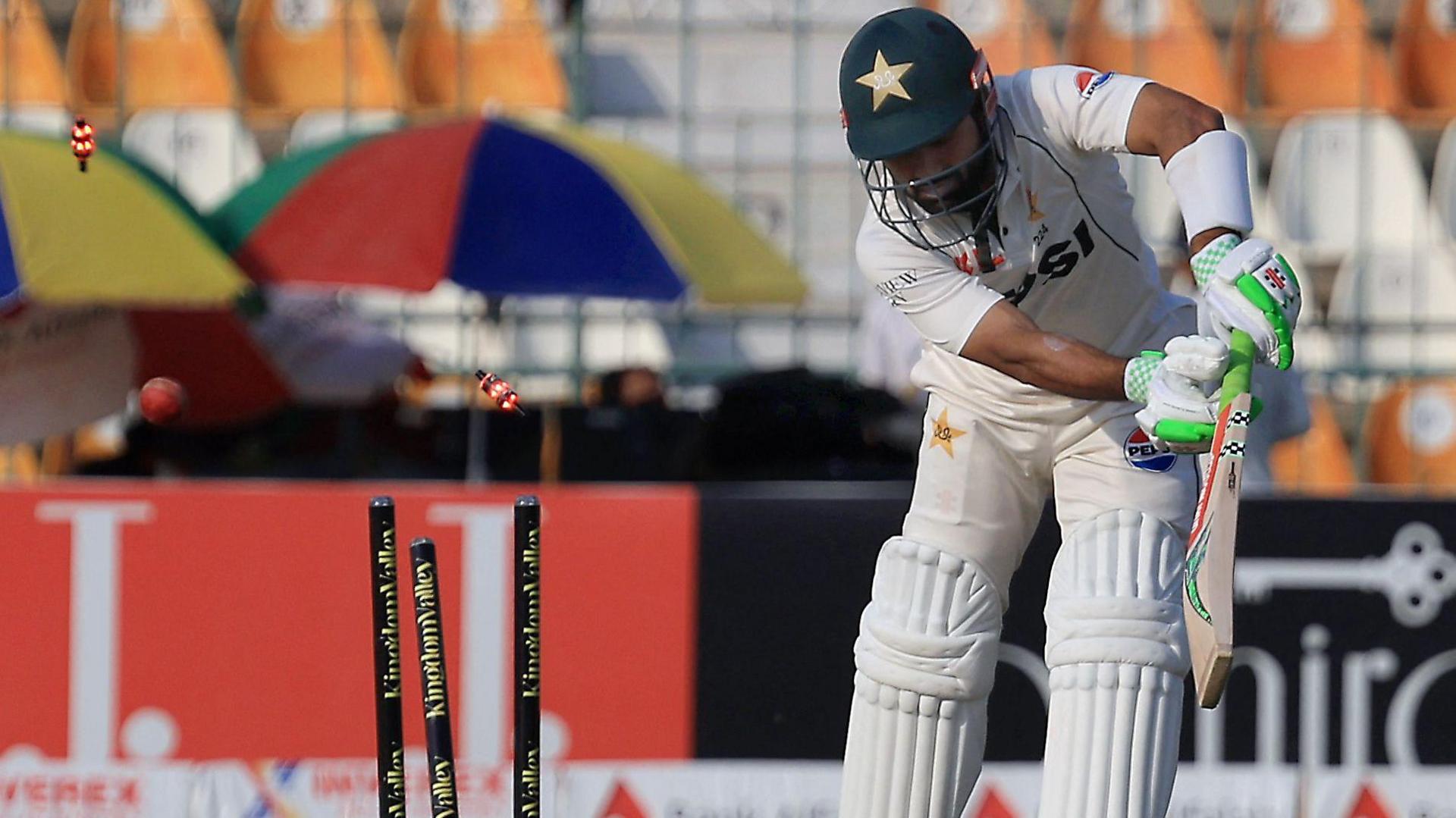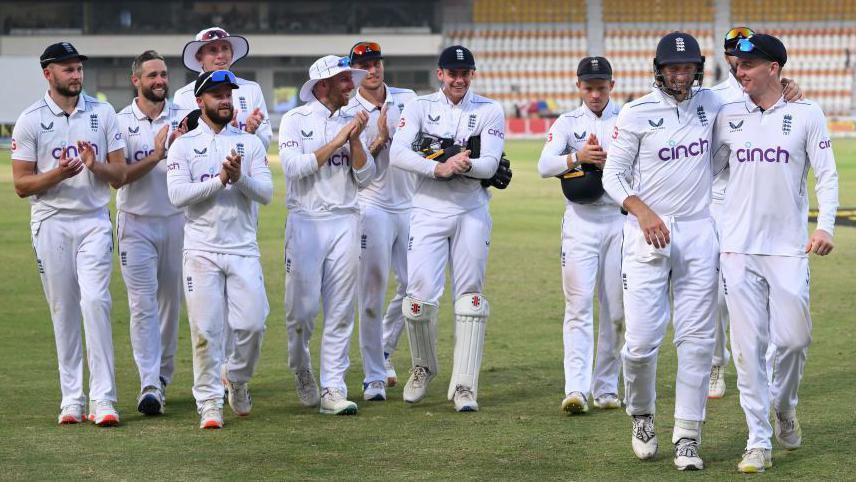Stokes, the pitch and fast Carse - first-Test talking points

England are the first team in Test history to concede more than 500 runs in the first innings and end up winning by an innings
- Published
England’s defeat of Pakistan in the first Test will forever be remembered as their most run-filled since the Second World War.
There is little time and no change of venue for the second Test, which begins on Tuesday in Multan.
And, even with four successive wins in this country and on the verge of a second series win here in as many years, there is plenty for England to chew over.
Stokes or no Stokes?
England have been without their talismanic captain for four consecutive matches and there were encouraging signs in Multan that Ben Stokes is close to returning.
Stand-in skipper Ollie Pope said it was “fingers crossed” and Stokes had enjoyed “a good week of training”.
The ideal scenario is Stokes is fully fit to come back and play a full role as an all-rounder, but that seems quite unlikely given how long he has been out, his injury history and the caution England will want to exercise over the their most prized asset.
If Stokes can bowl the amount of overs England require, he will probably come straight in for a seamer, most likely Chris Woakes.
If he can’t bowl at all, then England have the ticklish decision of whether to drop a batter or bowler. It could be Pope who has to make way.
There could be a halfway house, where Stokes can bowl some overs, then possibly squeezes more out of his frontline spinners and leans on Joe Root’s off-breaks.
"It's a tricky one: if he can bowl a bit, you might bring him in for the second spinner,” said former England captain Nasser Hussain on Sky Sports.
"Pope almost gave things away that Stokes will be fit, but he can't play as one of only three seamers, that is for certain. He has to be one of four seamers, which leaves either a spinner or batter vulnerable."
Jack the lad

Leach has now taken 22 wickets in four Tests in Pakistan
England threw their weight behind Shoaib Bashir as the number one spinner at the beginning of the home summer, but Leach out-bowled his Somerset team-mate when he returned for his first Test since January.
It’s simplistic just to look at Leach’s seven wickets against Bashir’s one as the yardstick of success – the devil is in the detail.
The two bowlers got similar amounts of turn, about 2.8 degrees, though Leach got more drift – 1.56 degrees to 0.75 – and was much more accurate. Nearly half of his deliveries would have hit the stumps, compared to 26% from Bashir, who strayed down the leg side a staggering 42% of the time.
Bashir, who turns 21 between Tests, would certainly benefit from Stokes’ return as captain. Admittedly it is a small sample size, but his bowling average jumps from 31.23 in six Tests under Stokes to 64.57 in four matches for Pope.
Bashir could find his best over the remainder of the series, though the prospect of Leach continuing to prosper raises questions. And if conditions change, necessitating a single spinner, what would England do?
Which brings us to…
Pitch imperfect?
Why was the pitch so good for the batters?
Have 22 yards of earth ever caused as much attention as the strip in Multan? The scrutiny will intensify, given the unusual scenario of playing back-to-back Tests at the same venue, albeit on a different track.
Cricket is a batter’s game. The term “good pitch” is misleading. Just because a pitch is good, therefore full of runs, it does not necessarily equate to entertaining cricket. Without England’s records, the first Test could have been turgid, such was the dominance of bat over ball.
According to Cricviz, the pitch for the first Test was the 11th-flattest since the ball-tracking era began in 2007. Historically, Multan and Rawalpindi – the venue for the third Test – are the two flattest Test pitches in the world.
At the end of the first Test, the part of the square likely to be used for the second Test was being watered. There is nothing unusual there. Indeed, Pakistan have options over the way they want to go for the second Test. They could produce something similar to the first Test, maybe leave grass on in the hope it will help the seamers, or let the pitch dry out and challenge England with spin.
“Pakistan would give themselves a better chance on a pitch that spins from the beginning,” former England seamer Steven Finn told BBC Sport. “If they play England on three pitches like shirt fronts, it will be 3-0 to England.”
You've got a fast Carse

Brydon Carse hit some of the Pakistan batters with sharp bouncers
Pace bowling was crucial to England’s unprecedented 3-0 series win here two years ago. Whereas the spinners on the opposing sides were well-matched, the touring seamers comfortably outperformed Pakistan’s - 26 wickets at an average of 23.2 compared to 11 at 62.7.
England’s new-look pace attack was a concern going into this first Test, yet they performed well, especially in reducing Pakistan to 59-5 in the second innings.
Brydon Carse is the third pace bowler to make his Test debut since July, as England build their Ashes-focused attack. The Durham man might well have got his cap in the home summer had he not been serving a ban for historic gambling offences.
In Multan, Carse did a decent imitation of his Durham team-mate Mark Wood, who is absent injured. In taking four wickets, as well as having one chalked off by DRS and a dropped catch, Carse averaged 85.2mph, bending his back to bowl 42% of his deliveries as bouncers.
As a comparison, on the last tour, Wood averaged 88.7mph and sent down half his deliveries as bumpers.
It can be frustrating to see England using bowlers of high pace only as battering rams – Jamie Overton, Olly Stone and Josh Tongue have had similar treatment – but sometimes needs must.
In the right conditions, Wood is given licence to show his considerable skills and the hope is Carse will one day get the same opportunity. Either way, England like him, and he only enhanced his reputation in Multan.
Out of the blocks

In 735 Tests hosted in Asia, teams batting in the first innings have scored 500+ on 102 occasions. Pakistan are the first of those teams in Test history to end up losing
This is a small point, though a potentially important one.
Multan was the fourth successive opening Test on an overseas tour that England have won. First in Pakistan two years ago, then New Zealand in 2023 and India in January.
All have come with a degree of adversity, too. In Rawalpindi in 2022, England were hit by illness, in New Zealand they dodged Cyclone Gabrielle and in India there was the Bashir visa debacle. Here, England were without Stokes, low on preparation, then shipped 556.
England have not won the opening Test of an away Ashes tour since 1986-87, when they defended the Ashes in Australia. The only other time since then they have won the urn down under was in 2010-11, when they batted the Aussies into oblivion for a famous first-Test draw.
Often, England leave Brisbane 1-0 down and already broken for the rest of the series. At least next winter they will start in Perth, although their record in Western Australia is even worse.
Still, if they can start quickly once more, the Ashes bid looks all the more realistic.
Related topics
- Published11 October 2024

- Published10 October 2024
